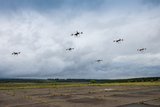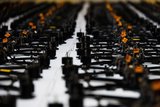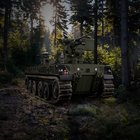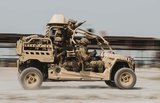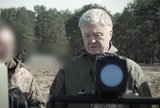Northrop Grumman, US Navy test UCAS refuelling
Northrop Grumman and the US Navy successfully completed a series of flight tests to demonstrate technology that could help extend the operating range and flight duration of future carrier-based unmanned systems. The testing was carried out on the X-47B UAV on 21 January 2012 in St Augustine, US.
The testing proved the functionality of the hardware and software that will enable the X-47B unmanned aircraft to demonstrate autonomous aerial refuelling (AAR) in 2014. The AAR activity is part of the Navy's Unmanned Combat Air System Carrier Demonstration (UCAS-D) program. Northrop Grumman is the Navy's UCAS-D prime contractor.
The AAR tests were conducted by a Northrop Grumman/Navy team using Calspan’s Variable Stability Learjet as the X-47B surrogate aircraft, and a K707 tanker provided by Omega Air Refuelling. The tests included simulated flight demonstrations of both boom/receptacle and probe-and-drogue aerial refuelling techniques. No fuel was exchanged between the aircraft during the test events.
According to Northrop Grumman, the Learjet surrogate was equipped with real or functional equivalents of the navigation systems, flight control processor and vision system that the X-47B will use to conduct refuelling operations. The aircraft contained no refuelling receptacle or refuelling probe. The K707, which is nearly identical in size and shape to an Air Force KC-135, was equipped with a Navy style refuelling drogue only.
For each simulated refuelling event, the Learjet/X-47B surrogate was piloted to a rendezvous position approximately one nautical mile from the tanker. Then the pilot transferred control of the aircraft to the X-47B's autonomous flight control processor, which controlled the Learjet during the test event.
The Northrop Grumman/Navy test team plans to conduct additional AAR surrogate testing using the same aircraft when flight-qualified versions of the relevant X-47B hardware and software become available.
The UCAS-D program plans to demonstrate in 2013 the ability of the tailless, autonomous, low-observable relevant X-47B demonstrator to safely operate from a Navy aircraft carrier, including launch, recovery, bolter and wave-off performance, followed by the autonomous aerial refuelling in 2014. The programme also plans to mature technologies required for potential future Navy unmanned air system programmes.
More from Uncrewed Vehicles
-
![Ready for the race: Air separation drone swarms vs. air defence systems]()
Ready for the race: Air separation drone swarms vs. air defence systems
As the dynamics of aerial combat rapidly evolve, Chinese scientists have engineered a sophisticated air separation drone model that can fragment into up to six drones, each capable of executing distinct battlefield roles and challenging the efficacy of current anti-drone defences such as the UK’s Dragonfire laser system.
-
![Israel’s MALE UAVs ‘must adapt’ to Iranian-made air defences]()
Israel’s MALE UAVs ‘must adapt’ to Iranian-made air defences
Advancements in air defence technologies have begun to reshape aerial combat dynamics in the Middle East, as illustrated by recent events involving the Israeli Air Force and Hezbollah.
-
![Hundreds more UAS sent to Ukraine forces with thousands more on the way]()
Hundreds more UAS sent to Ukraine forces with thousands more on the way
Both sides of the Russia-Ukraine war have been using UAS for effective low-cost attacks, as well as impactful web and social media footage. Thousands more have now been committed to Ukrainian forces.
-
![AI and software companies selected for US Army Robotic Combat Vehicle subsystems]()
AI and software companies selected for US Army Robotic Combat Vehicle subsystems
The US Army has intentions to develop light, medium and heavy variants of the Robotic Combat Vehicle (RCV) as part of the branche’s Next Generation Combat Vehicle family.
-
![DroneShield to improve software of DroneSentry-X C-UAS system under new contract]()
DroneShield to improve software of DroneSentry-X C-UAS system under new contract
DroneSentry-X, a cross-vehicle compatible, automated 360° C-UAS detect and defeat device, can offer 360° awareness and protection using integrated sensors. According to its manufacturer, it is suitable for mobile operations, on-site surveillance and on-the-move missions.
-
![Ukraine takes delivery of new indigenous C-UAS systems]()
Ukraine takes delivery of new indigenous C-UAS systems
Funded by the country’s former president, the new C-UAS systems will be sent to the frontline where they have already been tested against Russian invading forces.












